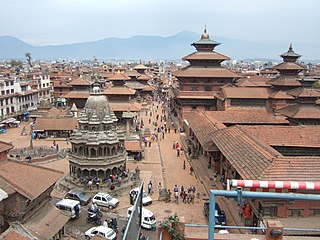List of Monuments
| ID | Name | Type | Location | District | Coordinates | Image |
|---|---|---|---|---|---|---|
| NP-KHP-01 | Kasthamandap | Kathmandu Durbar Square | Kathmandu | 27°42′14″N85°18′21″E / 27.704°N 85.30583°E |  | |
| NP-KHP-02 | Kabindrapur | Kathmandu Hanumandhoka Palace Area | Kathmandu |  | ||
| NP-KHP-03 | Shiva Temple | Kathmandu Durbar Square | Kathmandu | 27°42′14″N85°18′22″E / 27.704°N 85.306°E |  | |
| NP-KHP-04 | Ashok Vianayak Temple | Kathmandu Durbar Square | Kathmandu | 27°42′14″N85°18′14″E / 27.7039°N 85.3039°E |  | |
| NP-KHP-05 | Garudh | Kathmandu Hanumandhoka Palace Area | Kathmandu | 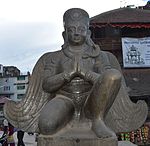 | ||
| NP-KHP-06 | Trailokya Mohan | Kathmandu Durbar Square | Kathmandu | 27°42′14″N85°18′15″E / 27.7039°N 85.3041°E |  | |
| NP-KHP-07 | Kumari Ghar (House) | Kathmandu Durbar Square | Kathmandu | 27°42′14″N85°17′51″E / 27.7039547°N 85.297543°E |  | |
| NP-KHP-08 | Maju Dega | Kathmandu Durbar Square | Kathmandu | 27°42′15″N85°18′15″E / 27.7042281°N 85.3040314°E | 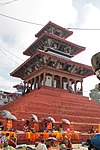 | |
| NP-KHP-09 | Joshi Agam house | Kathmandu Hanumandhoka Palace Area | Kathmandu |  | ||
| NP-KHP-10 | Visnhu Temple | Kathmandu Durbar Square | Kathmandu | 27°42′15″N85°17′51″E / 27.704214°N 85.2975059°E |  | |
| NP-KHP-11 | Shiva parwati (Navayogini) Temple | Kathmandu Hanumandhoka Palace Area | Kathmandu | 27°42′15″N85°18′23″E / 27.7042627°N 85.3063514°E |  | |
| NP-KHP-12 | Big Bell | Kathmandu Durbar Square | Kathmandu | 27°42′16″N85°18′24″E / 27.7045221°N 85.3066599°E | 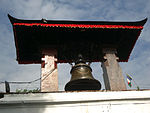 | |
| NP-KHP-13 | Krishna Temple | Kathmandu Hanumandhoka Palace Area | Kathmandu | 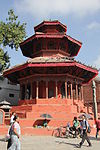 | ||
| NP-KHP-14 | Big Drum | Kathmandu Hanumandhoka Palace Area | Kathmandu | 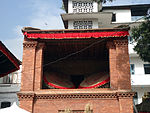 | ||
| NP-KHP-15 | Makhan Mahadev Temple | Kathmandu Hanumandhoka Palace Area | Kathmandu | 27°42′18″N85°18′27″E / 27.705006°N 85.3075488°E |  | |
| NP-KHP-16 | Jagannath Temple | Kathmandu Durbar Square | Kathmandu | 27°42′17″N85°18′18″E / 27.7046825°N 85.305046°E | 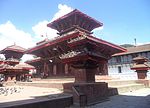 | |
| NP-KHP-17 | Gopinath Krishna Temple | Kathmandu Hanumandhoka Palace Area | Kathmandu |  | ||
| NP-KHP-18 | Indrapur | Kathmandu Hanumandhoka Palace Area | Kathmandu |  Upload Photo | ||
| NP-KHP-19 | Hanuman Dhoka Palace | Kathmandu Durbar Square | Kathmandu | 27°42′15″N85°18′19″E / 27.704272°N 85.3052283°E |  | |
| NP-KHP-20 | Talaju Temple | Kathmandu Durbar Square | Kathmandu | 27°42′18″N85°18′21″E / 27.7049482°N 85.3058677°E | 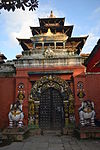 | |
| NP-KHP-21 | Shingha Dhoka | Kathmandu Durbar Square | Kathmandu | 27°42′17″N85°18′18″E / 27.7047458°N 85.3049407°E |  | |
| NP-KHP-22 | Sundari Chwok | Kathmandu Durbar Square | Kathmandu | 27°42′17″N85°18′19″E / 27.7047695°N 85.3053698°E |  Upload Photo | |
| NP-KHP-23 | Trishul Chwok | Kathmandu Hanumandhoka Palace Area | Kathmandu |  Upload Photo | ||
| NP-KHP-24 | Nasalchwok | Kathmandu Durbar Square | Kathmandu | 27°42′15″N85°18′19″E / 27.7042453°N 85.3052097°E |  | |
| NP-KHP-25 | Bhandarkhal | Kathmandu Durbar Square | Kathmandu | 27°42′20″N85°18′17″E / 27.7056862°N 85.3048494°E |  Upload Photo | |
| NP-KHP-26 | Mohanchwok | Kathmandu Hanumandhoka Palace Area | Kathmandu |  Upload Photo | ||
| NP-KHP-27 | Nagpokhari | Kathmandu Hanumandhoka Palace Area | Kathmandu |  Upload Photo | ||
| NP-KHP-28 | Mulchwok | Kathmandu Durbar Square | Kathmandu | 27°42′16″N85°18′27″E / 27.7043451°N 85.3074772°E |  | |
| NP-KHP-29 | Narshing Murthi | Kathmandu Hanumandhoka Palace Area | Kathmandu |  Upload Photo | ||
| NP-KHP-30 | Agmchhen Temple | Kathmandu Hanumandhoka Palace Area | Kathmandu |  | ||
| NP-KHP-31 | Dakhchwok | Kathmandu Hanumandhoka Palace Area | Kathmandu | 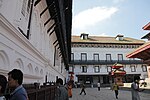 | ||
| NP-KHP-32 | Nhlchhechwok | Kathmandu Hanumandhoka Palace Area | Kathmandu |  Upload Photo | ||
| NP-KHP-33 | Lamchwok | Kathmandu Hanumandhoka Palace Area | Kathmandu |  Upload Photo | ||
| NP-KHP-34 | Basantapur Chwok | Kathmandu Durbar Square | Kathmandu | 27°42′14″N85°18′24″E / 27.7037662°N 85.3066074°E |  | |
| NP-KHP-35 | Kanheholchwok | Kathmandu Hanumandhoka Palace Area | Kathmandu |  | ||
| NP-KHP-36 | Dashainghar | Kathmandu Hanumandhoka Palace Area | Kathmandu |  Upload Photo | ||
| NP-KHP-37 | Panchamukhi Hanuman Statue | Kathmandu Hanumandhoka Palace Area | Kathmandu |  Upload Photo | ||
| NP-KHP-38 | Hanuman Temple | Kathmandu Durbar Square | Kathmandu | 27°42′16″N85°18′27″E / 27.7043618°N 85.3074629°E |  | |
| NP-KHP-39 | Sweta Bhairav | Kathmandu Durbar Square | Kathmandu | 27°42′16″N85°18′27″E / 27.7043618°N 85.3074629°E | 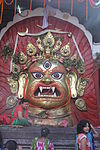 | |
| NP-KHP-40 | Degutale Temple | Kathmandu Hanumandhoka Palace Area | Kathmandu |  | ||
| NP-KHP-41 | Bhagawati Temple | Kathmandu Hanumandhoka Palace Area | Kathmandu |  Upload Photo | ||
| NP-KHP-42 | Jaldroni | Kathmandu Hanumandhoka Palace Area | Kathmandu | 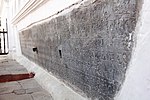 | ||
| NP-KHP-43 | Atkonarayan Temple and monuments surrounding | Kathmandu Hanumandhoka Palace Area | Kathmandu |  | ||
| NP-KHP-44 | Chaitya and idols | Kathmandu Hanumandhoka Palace Area | Kathmandu |  Upload Photo | ||
| NP-KHP-45 | Mahendra Museum | Kathmandu Durbar Square | Kathmandu | 27°42′16″N85°18′27″E / 27.7043618°N 85.3074629°E |  | |
| NP-KHP-46 | Sattal | Kathmandu Hanumandhoka Palace Area | Kathmandu |  Upload Photo | ||
| NP-KHP-47 | Gaddhi Baithak | Kathmandu Durbar Square | Kathmandu | 27°42′16″N85°18′25″E / 27.7044267°N 85.3069804°E |  | |
| NP-KHP-48 | Dabali | Kathmandu Hanumandhoka Palace Area | Kathmandu |  | ||
| NP-KHP-49 | Shiva Temple | Kathmandu Hanumandhoka Palace Area | Kathmandu |  Upload Photo | ||
| NP-KHP-50 | Singha Sattal | Kathmandu Durbar Square | Kathmandu | 27°42′13″N85°18′20″E / 27.7034725°N 85.3055803°E |  | |
| NP-KHP-51 | Bhagawati Temple | Kathmandu Hanumandhoka Palace Area | Kathmandu |  | ||
| NP-KHP-52 | Laxminarayan Temple | Kathmandu Hanumandhoka Palace Area | Kathmandu |  | ||
| NP-KHP-53 | Shiva Temple | Kathmandu Hanumandhoka Palace Area | Kathmandu |  Upload Photo | ||
| NP-KHP-54 | Sikhamu bahal | Kathmandu Hanumandhoka Palace Area | Kathmandu |  | ||
| NP-KHP-55 | Dabali | Kathmandu Hanumandhoka Palace Area | Kathmandu | 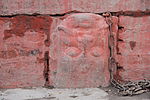 | ||
| NP-KHP-56 | Saraswati Temple | Kathmandu Hanumandhoka Palace Area | Kathmandu |  | ||
| NP-KHP-57 | Kaal Bhairav | Kathmandu Hanumandhoka Palace Area | Kathmandu | 27°42′17″N85°18′26″E / 27.70482°N 85.30715°E |  | |
| NP-KHP-58 | Kageshwor Temple | Kathmandu Hanumandhoka Palace Area | Kathmandu |  | ||
| NP-KHP-59 | Shiva Temple | Kathmandu Hanumandhoka Palace Area | Kathmandu |  Upload Photo | ||
| NP-KHP-60 | Kotilingeswor Temple | Kathmandu Hanumandhoka Palace Area | Kathmandu | 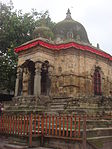 | ||
| NP-KHP-61 | Shiva Temple | Kathmandu Hanumandhoka Palace Area | Kathmandu |  Upload Photo | ||
| NP-KHP-62 | Shiva Temple | Kathmandu Hanumandhoka Palace Area | Kathmandu |  Upload Photo | ||
| NP-KHP-63 | Ganesh Bhairav | Kathmandu Hanumandhoka Palace Area | Kathmandu |  Upload Photo | ||
| NP-KHP-64 | Umamaheshwor Temple | Kathmandu Hanumandhoka Palace Area | Kathmandu |  | ||
| NP-KHP-65 | Kamadev | Kathmandu Hanumandhoka Palace Area | Kathmandu |  | ||
| NP-KHP-66 | Guhyeshwori | Kathmandu Hanumandhoka Palace Area | Kathmandu |  | ||
| NP-KHP-67 | Laxmi Narayan Temple | Kathmandu Hanumandhoka Palace Area | Kathmandu |  Upload Photo | ||
| NP-KHP-68 | Satyanarayan Temple | Kathmandu Hanumandhoka Palace Area | Kathmandu | 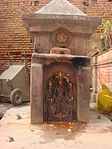 | ||
| NP-KHP-69 | Mahabishnu Temple | Kathmandu Durbar Square | Kathmandu | 27°42′16″N85°18′26″E / 27.7044129°N 85.3072135°E |  | |
| NP-KHP-70 | Narayan Temple | Kathmandu Hanumandhoka Palace Area | Kathmandu |  Upload Photo | ||
| NP-KHP-71 | Tarini Devi | Kathmandu Hanumandhoka Palace Area | Kathmandu | 27°42′18″N85°18′29″E / 27.7049156°N 85.308182°E |  | |
| NP-KHP-72 | Layakbahil | Kathmandu Hanumandhoka Palace Area | Kathmandu | 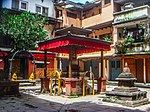 | ||
| NP-KHP-73 | Chaitya | Kathmandu Hanumandhoka Palace Area | Kathmandu |  Upload Photo | ||
| NP-KHP-74 | Chaityas | Kathmandu Hanumandhoka Palace Area | Kathmandu |  Upload Photo | ||
| NP-KHP-75 | Chaityas | Kathmandu Hanumandhoka Palace Area | Kathmandu |  Upload Photo | ||
| NP-KHP-76 | Dyochhen | Kathmandu Hanumandhoka Palace Area | Kathmandu |  | ||
| NP-KHP-77 | chaitya | Kathmandu Hanumandhoka Palace Area | Kathmandu | 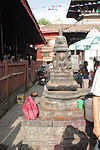 | ||
| NP-KHP-78 | Chaitya | Kathmandu Hanumandhoka Palace Area | Kathmandu |  Upload Photo | ||
| NP-KHP-79 | Aakash Bhairav Temple | Kathmandu Hanumandhoka Palace Area | Kathmandu | 27°42′21″N85°17′56″E / 27.7059°N 85.2989°E |  | |
| NP-KHP-80 | Chaitya | Kathmandu Hanumandhoka Palace Area | Kathmandu |  Upload Photo | ||
| NP-KHP-81 | Jhaldroni | Kathmandu Hanumandhoka Palace Area | Kathmandu |  Upload Photo | ||
| NP-KHP-82 | Kamdev Temple | Kathmandu Hanumandhoka Palace Area | Kathmandu | 27°41′59″N85°18′09″E / 27.6996°N 85.3024°E |  | |
| NP-KHP-83 | Ganesh Temple | Kathmandu Hanumandhoka Palace Area | Kathmandu |  | ||
| NP-KHP-84 | Rameshwor Temple | Kathmandu Hanumandhoka Palace Area | Kathmandu |  Upload Photo | ||
| NP-KHP-85 | Laxminarayan Temple | Kathmandu Hanumandhoka Palace Area | Kathmandu |  Upload Photo | ||
| NP-KHP-86 | Private House | Kathmandu Hanumandhoka Palace Area | Kathmandu |  Upload Photo | ||
| NP-KHP-87 | Chaitya Idol | Kathmandu Hanumandhoka Palace Area | Kathmandu |  Upload Photo | ||
| NP-KHP-88 | Sattal | Kathmandu Hanumandhoka Palace Area | Kathmandu |  Upload Photo | ||
| NP-KHP-89 | Kapaleshwor Mahadev Premises | Kathmandu Hanumandhoka Palace Area | Kathmandu |  Upload Photo | ||
| NP-KHP-90 | Ganesh Temple | Kathmandu Hanumandhoka Palace Area | Kathmandu |  | ||
| NP-KHP-91 | Jagannath Temple | Kathmandu Hanumandhoka Palace Area | Kathmandu |  Upload Photo | ||
| NP-KHP-92 | Srikrishna Balaram Rameshwor temple | Kathmandu Hanumandhoka Palace Area | Kathmandu |  | ||
| NP-KHP-93 | Kaliki devi temple | Kathmandu Hanumandhoka Palace Area | Kathmandu |  Upload Photo | ||
| NP-KHP-94 | Bharatlal shrestha home | Kathmandu Hanumandhoka Palace Area | Kathmandu |  Upload Photo | ||
| NP-KHP-95 | Gautam Manandhar house | Kathmandu Hanumandhoka Palace Area | Kathmandu |  Upload Photo | ||
| NP-KHP-96 | Sagar manandhar house | Kathmandu Hanumandhoka Palace Area | Kathmandu |  Upload Photo | ||
| NP-KHP-97 | Nijhi Ghar | Kathmandu Hanumandhoka Palace Area | Kathmandu |  Upload Photo | ||
| NP-KHP-98 | Nijhi Ghar | Kathmandu Hanumandhoka Palace Area | Kathmandu |  Upload Photo | ||
| NP-KHP-99 | Nijhi Ghar | Kathmandu Hanumandhoka Palace Area | Kathmandu |  Upload Photo | ||
| NP-KHP-100 | Kanteshwar Mahadev Temple | Kathmandu Hanumandhoka Palace Area | Kathmandu |  Upload Photo | ||
| NP-KHP-101 | Mahalakshmi Temple | Kathmandu Hanumandhoka Palace Area | Kathmandu |  Upload Photo | ||
| NP-KHP-102 | Purnamaya Maannadharko Ghar | Kathmandu Hanumandhoka Palace Area | Kathmandu |  Upload Photo | ||
| NP-KHP-103 | Mathuri Mannadharko Temple | Kathmandu Hanumandhoka Palace Area | Kathmandu |  Upload Photo | ||
| NP-KHP-104 | Tirtha bahadur Pradhan house | Kathmandu Hanumandhoka Palace Area | Kathmandu |  Upload Photo | ||
| NP-KHP-105 | Bichhe bahal | Kathmandu Hanumandhoka Palace Area | Kathmandu |  Upload Photo | ||
| NP-KHP-106 | Dyochhen | Kathmandu Hanumandhoka Palace Area | Kathmandu |  Upload Photo | ||
| NP-KHP-107 | Pati | Kathmandu Hanumandhoka Palace Area | Kathmandu |  Upload Photo | ||
| NP-KHP-108 | Gorakhsya bahadur pradhan house | Kathmandu Hanumandhoka Palace Area | Kathmandu |  Upload Photo | ||
| NP-KHP-109 | Nijhi Ghar | Kathmandu Hanumandhoka Palace Area | Kathmandu |  Upload Photo | ||
| NP-KHP-110 | Nijhi Ghar | Kathmandu Hanumandhoka Palace Area | Kathmandu |  Upload Photo | ||
| NP-KHP-111 | Nijhi Ghar | Kathmandu Hanumandhoka Palace Area | Kathmandu |  Upload Photo | ||
| NP-KHP-112 | Nijhi Ghar | Kathmandu Hanumandhoka Palace Area | Kathmandu |  Upload Photo | ||
| NP-KHP-113 | S Thirtarajko Ghar | Kathmandu Hanumandhoka Palace Area | Kathmandu |  Upload Photo | ||
| NP-KHP-114 | Shivalay | Kathmandu Hanumandhoka Palace Area | Kathmandu |  Upload Photo | ||
| NP-KHP-115 | Govinda das shrestha house | Kathmandu Hanumandhoka Palace Area | Kathmandu |  Upload Photo | ||
| NP-KHP-116 | Ganesh bahadur shrestha house | Kathmandu Hanumandhoka Palace Area | Kathmandu |  Upload Photo | ||
| NP-KHP-117 | Jayandra bahadur karmacharya house | Kathmandu Hanumandhoka Palace Area | Kathmandu |  Upload Photo | ||
| NP-KHP-118 | Byadhya prasad shah house | Kathmandu Hanumandhoka Palace Area | Kathmandu |  Upload Photo |


